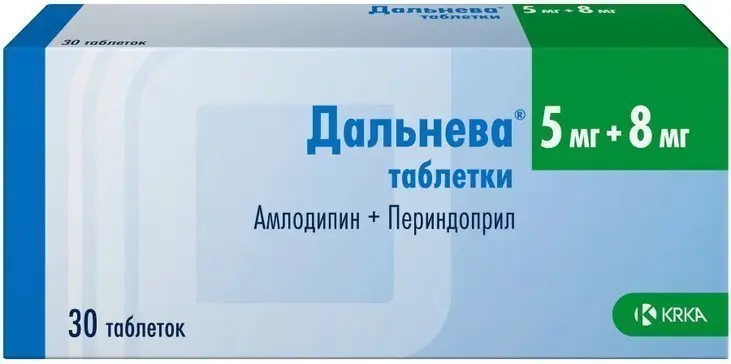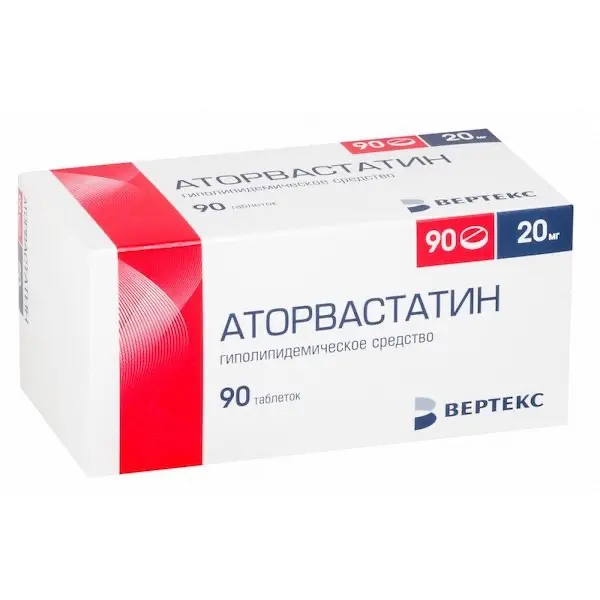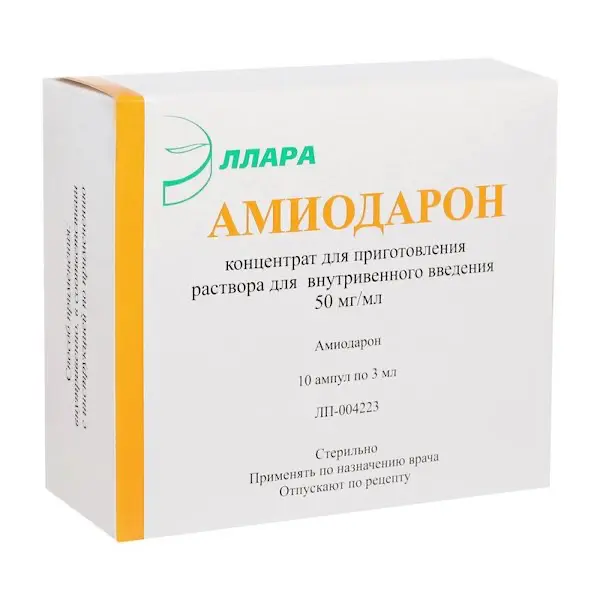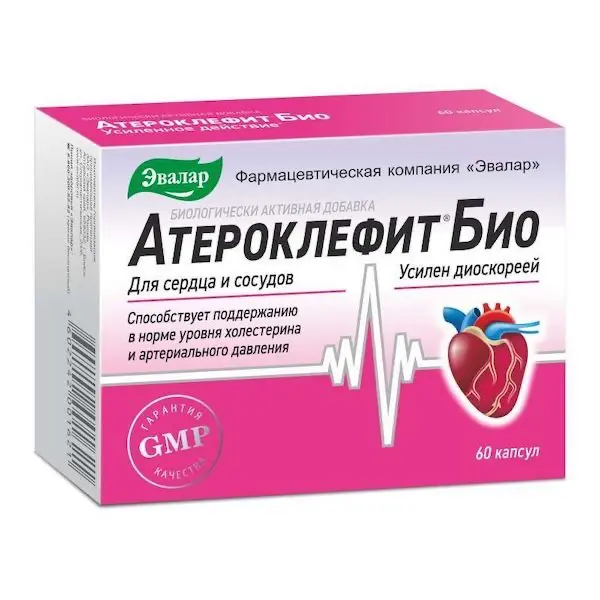Description
Dalneva Pharmacodynamics
Amlodipine
Amlodipine is a BMCC, a dihydropyridine derivative. Amlodipine inhibits transmembrane transition of calcium ions into cardiomyocytes and smooth muscle cells of the vascular wall.
The antihypertensive effect of amlodipine is due to a direct relaxing effect on the smooth muscle cells of the vascular wall. The detailed mechanism by which amlodipine exerts antianginal action is not fully established, but it is known that amlodipine reduces the overall coronary load by two actions:
– It causes peripheral arterioles to dilate, reducing total peripheral vascular resistance (PPR) (postload). Since the heart rate (HR) does not change, myocardial oxygen demand is reduced;
– causes dilation of coronary arteries and arterioles in both ischemic and intact zones. Their dilatation increases myocardial oxygen supply in patients with vasospastic angina (Prinzmetal angina or variant angina).
In patients with arterial hypertension (AH), administration of amlodipine once daily provides clinically significant reduction of blood pressure (BP) in standing and lying position for 24 hours. Antihypertensive effect develops slowly, and therefore the development of acute arterial hypotension is uncommon.
In patients with angina pectoris, taking amlodipine once daily increases total exercise time, increases time to angina attack development and to ST-segment depression by 1 mm, and decreases angina attack frequency and nitroglycerin consumption under the tongue.
Amlodipine has no adverse metabolic effects and does not affect plasma lipid concentrations.
The drug may be used in patients with concomitant bronchial asthma, diabetes mellitus and gout.
Coronary heart disease (CHD)
Efficacy evaluation results suggest that amlodipine administration is characterized by fewer hospitalizations for angina and revascularization procedures in patients with coronary artery disease (CHD).
Perindopril
Perindopril is an inhibitor of the enzyme that converts angiotensin I to angiotensin II. ACE, or kininase II, is an exopeptidase that both converts angiotensin I into the vasoconstrictor angiotensin II and breaks down bradykinin, which has a vasodilator effect, into an inactive heptapeptide.
Since ACE inactivates bradykinin, ACE suppression is accompanied by an increase in both circulating and tissue kallikrein-kinin system activity, and the prostaglandin system is also activated.
Perindopril has a therapeutic effect due to its active metabolite, perindoprilat. Other metabolites have no inhibitory effect on ACE under in vitro conditions.
Arterial hypertension.
Perindopril is a drug for the treatment of AH of any severity. Against the background of its use, a decrease in both systolic and diastolic BP in “lying” and “standing” positions is observed.
Perindopril decreases RPS, which leads to a decrease in BP and improvement of peripheral blood flow without changing HR.
As a rule, perindopril administration increases renal blood flow, glomerular filtration rate (GFR) does not change.
Antihypertensive effect of the drug reaches a maximum of 4-6 hours after a single oral administration and lasts for 24 hours.
Antihypertensive effect 24 hours after a single oral administration is about 87-100% of the maximum antihypertensive effect.
Reduction of BP is achieved fairly quickly. The therapeutic effect occurs in less than 1 month from the beginning of therapy and is not accompanied by tachyphylaxis. Termination of treatment does not cause the effect of “ricochet”.
Perindopril has a vasodilator effect, helps to restore elasticity of large arteries and vascular wall structure of small arteries, and also reduces left ventricular hypertrophy.
Stable CHF
The efficacy of perindopril in patients (12218 patients over 18 years of age) with stable CHD without clinical symptoms of chronic heart failure (CHF) was studied in a 4-year study. 90% of the study participants had previously undergone acute myocardial infarction and/or revascularization procedure.
Most patients received standard therapy in addition to the study drug, including antiaggregants, hypolipidemic agents, and beta-adrenoblockers. The combined endpoint including cardiovascular mortality, nonfatal myocardial infarction and/or cardiac arrest with successful resuscitation was chosen as the main efficacy criterion.
Therapy with perindopril tretbutylamine at a dose of 8 mg/day once daily (equivalent to 10 mg of perindopril arginine) resulted in a significant absolute risk reduction for the combined endpoint of 1.9% in patients who had previously undergone myocardial infarction and/or revascularization procedure, the absolute risk reduction was 2.2% compared with the placebo group.
Dual blockade of the renin-angiotensin-aldosterone system (RAAS)
There are data from clinical trials of combination therapy with an ACE inhibitor and an angiotensin II receptor antagonist (ARA II).
The use of ACE inhibitors in combination with ARA II in patients with diabetic nephropathy is contraindicated. There are data from a clinical trial investigating the beneficial effects of adding aliskiren to standard therapy with an ACE inhibitor or ARA II in patients with type 2 diabetes and/or chronic kidney disease or cardiovascular disease, or with a combination of these conditions. The study was terminated early due to an increased risk of adverse outcomes. Cardiovascular death and stroke were observed more often in the group of patients receiving aliskiren compared to the placebo group; also adverse events and serious adverse events of special interest (hyperkalemia, arterial hypotension and renal dysfunction) were registered more often in the aliskiren group than in the placebo group.
Amlodipine + perindopril
Efficacy with long-term use of amlodipine in combination with perindopril and atenolol in combination with bendroflumethiazide in patients aged 40 to 79 years with AH and at least three of the additional risk factors listed: Left ventricular hypertrophy on ECG or echocardiography, type 2 diabetes mellitus, peripheral arterial atherosclerosis, previous stroke or transient ischemic attack, male gender, age 55 or older, microalbuminuria or proteinuria, smoking, total cholesterol/high-density lipoprotein cholesterol ? 6, early development of CHD in immediate family members was studied in the ASCOT-BPLA study.
The main criterion for efficacy assessment was the combined rate of nonfatal myocardial infarction (including pain-free) and fatal outcomes of CHD.
The incidence of complications provided by the main assessment criterion was 10% lower in the amlodipine/perindopril group than in the atenolol/bendroflumethiazide group, but this difference was not statistically significant. In the amlodipine/perindopril group, there was a significant reduction in the incidence of complications, stipulated by additional efficacy criteria (except for fatal and nonfatal heart failure).
Indications
– Arterial hypertension and/or coronary heart disease: stable angina pectoris in patients requiring perindopril and amlodipine therapy.
Contraindications .
– Hypersensitivity to perindopril or other ACE inhibitors, amlodipine and other dihydropyridine derivatives, as well as to excipients included in the preparation.
– History of angioedema (Quincke’s edema) (including history of other ACE inhibitors).
– Hereditary/idiopathic angioedema.
– Concomitant use with aliskiren and drugs containing aliskiren in patients with diabetes mellitus and/or moderate or severe renal impairment (FFR < 60 ml/min/1.73 m2 body surface area) (see sections “Interaction with other medicinal products” and “Pharmacological properties. Pharmacodynamics”).
– Concomitant use with ARA II in patients with diabetic nephropathy (see section “Cautions”).
– Concomitant use with neutral endopeptidase inhibitors (e.g. drugs containing Sacubitril) due to the high risk of angioedema.
– Extracorporeal therapy leading to blood contact with negatively charged surfaces (see section “Interaction with other medicinal products”).
– Severe bilateral stenosis of the renal arteries or stenosis of the artery of the only functioning kidney (see section “Special indications”).
– Severe arterial hypotension (systolic BP less than 90 mm Hg).
– Shock (including cardiogenic).
– Left ventricular outflow tract obstruction (e.g., clinically significant aortic stenosis).
– Hemodynamically unstable heart failure after acute myocardial infarction.
– Renal insufficiency (creatinine clearance [CK] less than 60 ml/min).
– Pregnancy and breastfeeding (see section “Administration during pregnancy and breastfeeding”).
– Age under 18 years (efficacy and safety have not been established).
Dosage and administration
- Orally, one tablet once a day, preferably in the morning, before meals.
- The dose of Dalneva® is adjusted after previously performed dose adjustment of individual components of the drug: perindopril and amlodipine in patients with AH and stable angina pectoris.
- If it is therapeutically necessary, the dose of Dalneva® can be changed on the basis of individual selection of doses of individual components: amlodipine 5 mg + perindopril 4 mg or amlodipine 10 mg + perindopril 4 mg, or amlodipine 5 mg + perindopril 8 mg, or amlodipine 10 mg + perindopril 8 mg.
- Maximum daily dose: amlodipine 10 mg + perindopril 8 mg.
- Special patient groups
- Patients with impaired renal function
- Dalneva® medicinal product can be administered in patients with CK equal or more than 60 ml/min.
- Dalneva® is contraindicated in patients with IQ less than 60 ml/min. Individual selection of perindopril and amlodipine doses is recommended for such patients.
- Changes in amlodipine plasma concentration do not correlate with the severity of renal failure.
- Elderly patients and patients with hepatic dysfunction
The initial dose of Dalneva® should be reduced to the lowest dose of amlodipine (i.e. to 1 tablet of amlodipine 5 mg + perindopril 4 mg or amlodipine 5 mg + perindopril 8 mg). - Children and adolescents
Dalneva® should not be administered to children and adolescents younger than 18 years of age because there are no data on efficacy and safety of perindopril and amlodipine use in these groups of patients both in monotherapy and as part of combination therapy.





